M24 Sniper Weapon System
The M24 Sniper Weapon System (SWS) is the military and police version of the Remington Model 700 rifle, M24 being the model name assigned by the United States Army after adoption as their standard sniper rifle in 1988. The M24 is referred to as a "weapon system" because it consists of not only a rifle, but also a detachable telescopic sight and other accessories.
| Rifle, Caliber 7.62 mm, Sniper Weapon System, M24 | |
|---|---|
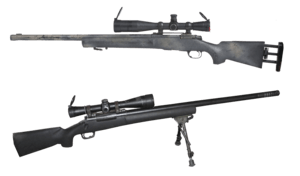 The M24 rifle | |
| Type | Sniper rifle |
| Place of origin | United States |
| Service history | |
| In service | 1988–present |
| Used by | See Users |
| Wars | Salvadoran Civil War Gulf War War in Afghanistan Iraq War Syrian Civil War[1] Iraqi Civil War (2014–2017)[2] |
| Production history | |
| Designed | 1988 |
| Manufacturer | Remington Arms |
| Produced | 1988-present |
| Variants | M24A2, M24A3, M24E1 |
| Specifications | |
| Mass | 5.4 kg (11.88 lbs) empty, w/. sling, without scope (M24) 7.3 kg (16 lbs) max weight with day optical sight, sling swivels, carrying strap, fully loaded magazine[3] 5.6 kg (12.32 lbs) empty, w/sling, without scope (M24A3). |
| Length | 1,092 mm (43 in) (M24A1, M24A2); (46.5 in) (M24A3) |
| Barrel length | 610 mm (24 in)(M24A1, M24A2); 685.8 mm (27 in) (M24A3) |
| Cartridge | 7.62×51mm NATO (M24, M24A2)[4] .338 Lapua Magnum (M24A3)[4] |
| Action | Bolt-action |
| Rate of fire | 20 rpm |
| Muzzle velocity | 2,580 ft/s (790 m/s) w/M118LR Sniper load (175 gr.) |
| Effective firing range |
|
| Feed system | 5-round internal magazine (M24), 5-round detachable box magazine (M24A2, M24A3) |
| Sights | Telescopic; detachable backup iron sights |
The M24 SWS has the "long action" bolt version of the Remington 700 receiver but is chambered for the 7.62×51mm NATO "short action" cartridge that has an overall length of 2.750 inches (69.85 mm). The "long action" allows the rifle to be re-configured for dimensionally larger cartridges up to 3.340 inches (84.84 mm) in overall length.
The M24 originally came tapped for the Leupold Ultra M3A 10×42mm fixed-power scope, which came with a circle-shaped mil-dot glass-etched reticle. This was later replaced in 1998 by the Leupold Mk 4 LR/T M1 10×40mm fixed-power scope with an elongated-shaped mil-dot wire reticle.[5]
The first number is the scope's magnification (10) and the second number in millimeters (40mm) is the diameter of the objective lens. A fixed power scope has only one magnification (e.g., 10×) and a variable power scope can be adjusted to focus between a range of magnifications (e.g., 3–9× is adjustable from a minimum power of 3× to a maximum power of 9×). The rifle itself comes with a detachable Harris 9–13" 1A2-LM or Harris 9–13" 1A2-L bipod unit.
The M24 SWS was to be replaced with the M110 Semi-Automatic Sniper System, a contract awarded to Knight's Armament Company. However, the Army still continued to acquire M24s from Remington until February 2010 and upgraded to the A2 and M24E1 standard in many cases, continuing to serve.[6] The Army chose to upgrade all its M24 rifles in the arsenals to the M2010 Enhanced Sniper Rifle, with the final M24 being converted in April 2014.[7]
Specifications
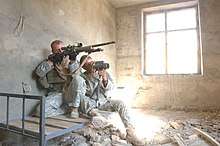
Scope: Leupold Ultra M3A 10×42mm fixed power, or Leupold Mk 4 LR/T M3 10×40mm fixed power scope. Detachable emergency Redfield-Palma International back-up iron sights, they are attached to iron sight bases that are screwed into drilled and tapped holes machined into the front of the barrel and back on the left side of the receiver. In 2001 when Remington had the second contract to the U.S. military, minor changes were done to the M24. These changes included two piece Leupold Mark 4 scope ring bases instead of the one piece on the first series rifles, and a switch from Redfield-Palma International iron sights to another manufacturer OK Weber. Redfield was out of business by then, necessitating a change.
Barrel: Made of 416R stainless steel. The bore twist is 1-turn-in-11.25 inches [1:285.75 mm] and the rifling is five radial lands and grooves (5-R) with a right-hand (RH) twist. Because of the odd number of lands, none of the lands are 180° apart, i.e. in direct opposition. This results in less bullet deformation, which (at least in theory) produces more consistent point of impact. In 5-R rifling, the "side" of the land is cut at a 65° angle, rather than 90° in conventional rifling. This results in less barrel fouling, and more consistent point of impact, compared to conventional rifling when relatively high numbers of rounds are fired between cleaning, as might be expected in military applications.
Stock: H-S Precision PST-024, the model with the fixed cheek piece, adjustable LOP and hinged floorplate. The stock secures the action via an aluminum bedding block to keep it rigid. The barrel is free floating. A twin-strut extension that pulls out of the butt allows a 2-inch [50.8mm] adjustment to length-of-pull, as well as allowing for the weapon to fit inside the M-1950 Weapon Container for Airborne Operations. This is effected by a thick wheel on a central grooved pillar for adjusting the length and a thin locking ring behind it locks the thick wheel in place. The stock is primarily made from a polymer foam reinforced with fiberglass, carbon fiber, and Kevlar to reduce weight and then painted with a heavy duty polane paint. They were rigorously tested before being approved by Remington and the military.
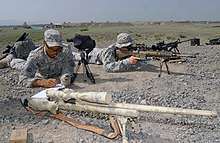
Accuracy: According to MIL-R-71126(AR), 3.15.7 Targeting and Accuracy, The rifle shall achieve the dispersion set forth below when fired from a Government approved machine rest. The average mean radius shall be less than or equal to the values stated below. The minimum rate of fire for conducting this test shall be three rounds per minute.[3]
Range / Average Mean Radius (AMR) — Mean Radius (MR) expresses the average distance of all the shots from the center of the shot group. AMR averages the MR of several shot groups.
- 200 yards (183 m): 1.3 inches
- 273 yards (250 m): 1.4 inches
- 300 yards (274 m): 1.9 inches
The radial distance from the calculated center of impact of the first target compared to the calculated center of impacts of the subsequent targets shall be less or equal to 1.086 MOA (3.3 inches @ 300 yards, 2.2 inches @ 200 yards, 2.4 inches @ 200 meters) on an average basis.
The actual rifle requirements for accuracy were .35 MOA from a machine rest and according to Major John Mende (ret.) this accuracy had to be maintained to 10,000 rounds. He stated, "Interesting side note was there was a 10,000 round requirement for the barrel to maintain the original accuracy. In fact after some 10,000 round tests we discovered the accuracy improved. A few barrels were tested past 20,000 and accuracy never went below the original accuracy requirement."[8]
Maximum effective range is given as 800 meters (875 yd), but record shots have been made with the M24 at over 1,000 meters (1,094 yd). Meanwhile, the standard optical sight has a maximum elevation adjustment of 1,000 meters (1,094 yd).
Match-grade ammunition
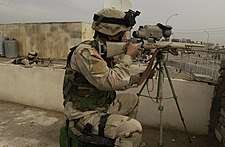
- 7.62 × 51mm M118 Match Grade: A 168-grain round.
- 7.62 × 51mm M118LR Long Range: A 175-grain round using Sierra MatchKing Hollow Point Boat Tail projectiles.
- 7.62mm M118 Long Range Performance Data:
- Muzzle velocity (nominal): 2,580 feet per second (786 m/s)
- Chamber pressure (typical): 52,000 psi (360 MPa)
- Action time (max): 4 ms
- Average horizontal spread at 1,000 metres (1,094 yd): 10.3 in (0.899 MOA)
- Average vertical spread at 1,000 metres (1,094 yd): 14 in (1.222 MOA)[10]
According to JBM Ballistics,[11] using the G7 ballistic coefficient provided by Bryan Litz, the 7.62mm M118 Long Range 7.62×51mm NATO cartridge, when fired at its nominal muzzle velocity of 786 m/s (2,580 ft/s), should have approximately 878 metres (960 yd) supersonic range under International Standard Atmosphere conditions at sea level (air density ρ = 1.225 kg/m3).
- 7.62 × 51mm MK 316 MOD 0 Special Ball, Long Range: A 175-grain round consisting of Sierra MatchKing Hollow Point Boat Tail projectiles, Federal Cartridge Company match cartridge cases and Gold Medal Match primers and an undisclosed modified extruded propellant. The 7.62 × 51mm MK 316 MOD 0 Special Ball, Long Range cartridges have an accuracy requirement based around 10-round shotgroups. The Propellant has been verified as modified version of IMR 4064 as stated in DODIC: AB39 NSN: 1305-01-567-6944.
- The average extreme spread for 10-round shotgroups shall be less than or equal to the following values:
- 600 yd: 7.0 in (first Production Lot). This equates to a ≤ 1.1 MOA requirement at 548.6 m.
- 300 yd: 3.5 in (after first Production Lot). This equates to a ≤ 1.1 MOA requirement at 274.3 m.
The maximum muzzle velocity standard deviation is set at 15 ft/s (4.57 m/s). Information published on acceptance tests regarding five MK 316 MOD 0 cartridge production lots indicated a sub 2.4 in at 300 yd performance. This equates to a sub 0.8 MOA performance at 274.3 m for the listed ammunition lots.[12]
- IMI 7.62 × 51mm 175 Grain Match OTM-BT Razor Core: a 175-grain match grade sniping round loaded with Sierra MatchKing Hollow Point Boat Tail projectiles manufactured by Israeli Military Industries, and in use by the Israel Defense Forces.
This IMI ammunition has an average muzzle velocity of 770 m/s (2,526 ft/s) from a 56 cm (22 in) long barrel and shoots groups of ≤ 25.4 cm (10 in) extreme spread at a distance of 550 m (600 yd), an accuracy that equals ≤ 1.6 MOA.[13][14]
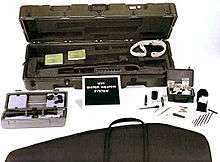
M24 variants
XM24A1
An experimental variant re-chambered for the .300 Winchester Magnum (7.62×67mm) round. It was not adopted by the US Army due to concerns that operatives in the field would not be able to acquire the special ammo. Also, the available .300 Winchester Magnum ammo that was procured sometimes misfired due to incompletely-burned propellant in the longer cartridge.
M24A2
Remington has developed an improved version of the M24 rifle, known as the M24A2. The A2 model features a detachable 5-round magazine, top-mounted and adjustable side-mounted Picatinny rails (advertised by Remington as "MARS", or Modular Accessory Rail System), barrel modifications designed to accommodate a sound suppressor, and an improved H-S Precision PST-026 stock with adjustable cheek height and length of pull. Existing M24s can also be converted into M24A2s, which replaces the stock and adds the new detachable magazine feed. The conversion requires a re-barreling of the weapon so it can take the OPS silencer.
M24A3
Remington developed the M24A3 SWS, a variant of the M24 chambered for the .338 Lapua Magnum round (8.58×70mm) and feeding from a 5-round detachable box magazine.[15] It comes tapped for the Leupold Mk 4 M1LR/T 8.5–25×50mm Variable Power day scope. It can also use detachable front and rear Back-Up Iron Sights in an emergency (BUIS units are standard accessories that can be fitted to the Picatinny Rail that runs on the top of the receiver and along the barrel).
U.S. Army 2009 solicitation for an M24 reconfiguration
The U.S. Army put out a solicitation in May 2009 for reconfiguring M24 Sniper Weapon Systems currently available in Army inventory consisting of a:[16]
- Rebarreling/rechambering the SWS's barrel optimized to accommodate Mk 248 (DODIC A191) .300 Winchester Magnum ammunition.
- Replacement of existing weaver rails with a MIL-STD-1913 rail capable of accommodating both a day optic and in-line forward mounted, AN/PVS-26 (NSN 5855-01-538-8121) image intensified (I2) night vision device.
- Reconfiguring the stock with a stock that incorporates a detachable box magazine, adjustable comb and length of pull.
- Addition of a detachable sound suppressor as well as any necessary barrel modifications required for a sound suppressor interface.
- Replacement of the existing day optic sight (DOS) and rings with an Army specified variable power day optic and compatible rings.
The US government purchased MK 248 MOD 1 .300 Winchester Magnum match-grade ammunition in 2009 for use in .300 Winchester Magnum sniper rifles like the U.S. Navy Mk.13 MOD 5 rifle or reconfigured M24 SWSs. This ammunition was developed as a .300 Winchester Magnum Match Product Improvement (PIP) and uses the 14.26 g (220 gr) Sierra MatchKing Hollow Point Boat Tail (HPBT) very-low-drag bullet fired at a nominal muzzle velocity of 869 m/s (2,850 ft/s) ± 15.2 m/s (50 ft/s). According to the U.S. Navy this ammunition should increase the maximum effective range of .300 Winchester Magnum sniper rifle systems to 1,370 m (1,500 yd), decrease wind deflection on bullets in flight and use a reduced muzzle flash propellant that remains temperature stable across an operational temperature range of −32 °C to 74 °C (−25 °F to 165 °F).[17][18][19] According to JBM Ballistics,[11] using the G7 ballistic coefficient provided by Bryan Litz, the Mk 248 MOD 1 .300 Winchester Magnum cartridge, when fired at its nominal muzzle velocity of 869 m/s (2,850 ft/s), should have approximately 1,286 m (1,406 yd) supersonic range under International Standard Atmosphere conditions at sea level (air density ρ = 1.225 kg/m3).
2010 M24E1 Enhanced Sniper Rifle reconfiguration competition

In September 2010 the United States Army's Joint Munitions and Lethality Contracting Center awarded Remington a Firm Fixed Price Indefinite Delivery/Indefinite Quantity contract (W15QKN-10-R-0403) for the upgrade of up to 3,600 M24 Sniper Weapon Systems currently fielded to the Army pending type classification as the M24E1 Enhanced Sniper Rifle (ESR).[20] Later the Enhanced Sniper Rifle was classified as the XM2010. The major configuration change for this system is the conversion from 7.62×51mm NATO to dimensionally larger .300 Winchester Magnum ammunition exploiting the M24's "long action" bolt to provide additional precision and range.[21][22]
The M24E1/XM2010 is considered a "total conversion upgrade", by which the barrel, stock, magazines, muzzle brake, suppressor, and even the optics will be changed. Besides the rechambering and rebarreling with a 610 mm (24 in) long, 254 mm (1 in 10 inch) twist rate (5R) hammer-forged barrel the main reconfiguration changes compared to 7.62×51mm NATO chambered M24 rifles are:[23]
- Fitting a new chassis (stock) assembly, which maximizes the amount of physical adjustments for the sniper to provide a better user customized fit. The chassis has a folding buttstock that shortens the system for easier transport and better concealment during movement and accommodates the mounting of accessories via removable Mil Std 1913 Picatinny Rails.
- Fitting a 5-round detachable box magazine.
- Fitting a quick-attachable/detachable Advanced Armament Corp. sound suppressor with muzzle brake.
- Fitting a Leupold Mark 4 6.5–20×50mm ER/T M5 Front Focal variable power telescopic sight featuring a 30 mm tube diameter, first focal plane Horus Vision H-37 grid system range estimation reticle and Bullet Drop Compensation.[24][25]
- Applying advanced corrosion resistant coatings throughout the system.
According to Remington Arms each rifle is tested to meet (and typically exceeds) the requirement to fire ≤ 1 MOA (less than a 2-inch shot group at 200 yards) before being released for fielding.[21]
Based on the results and feedback from troops, the U.S. Army decided in May 2011 to replace its entire fleet of M24s, ordering a total of 2,558 M2010 Enhanced Sniper Rifles. By September 2012, the Army had fielded more than 1,400 systems as part of an urgent material release. The M2010 achieved Type Classification-Standard in July 2013 and Full Materiel Release in September 2013, supporting procurement for the balance of the Army requirement. On April 25, 2014, the 2,558th M2010 Enhanced Sniper Rifle was completed.[26][27][7]
IDF modernized M24

In 2019 the Israel Defense Forces started to upgrade the M24 and replace the stock and receiver of the old M24 rifles with a modern stock with AR15/M16 pistol grip, adjustable stock, magazine feeding and Picatinny rails around the barrel.
Differences between M24 and M40
The U.S. Marine Corps also uses the Remington 700/40x action as the basis for its M40 Sniper Weapon System.[28] The primary difference between the U.S. Army and the U.S. Marine Corps rifles is that while the U.S. Marine Corps M40 variants use the short-action version of the Remington 700/40x (which is designed for shorter cartridges such as the .308 Winchester/7.62×51 mm NATO), the U.S. Army M24 uses the Remington 700 Long Action.[28] Despite the fact that the M24 comes fitted with a 7.62×51mm NATO barrel upon issue, retaining the longer action allows them to reconfigure the rifle in dimensionally larger cartridge chamberings if necessary (which has been the case during the longer engagement distances during Operation Enduring Freedom). Long actions also increase reliability and reduce jamming by reducing the angle of cartridges leaving the magazine and permit long, low-drag heavy-for-caliber bullets to be loaded in short-action cartridges that otherwise would not fit in short-action cartridges, magazines and receivers.
The U.S. Army reconfigured their M24 rifles to M2010 Enhanced Sniper Rifles rechambering the original M24 rifles to .300 Winchester Magnum. The USMC M40A3 uses a 25 inches (635 mm) Schneider barrel and the U.S. Army M24 used a 24 inches (610 mm) Rock Creek 5R barrel.
Users





















See also
References
- http://www.foxnews.com/world/2018/05/15/gave-us-trucks-and-ammunition-to-al-qaeda-chaotic-us-effort-to-arm-syrian-rebels.html
- https://www.youtube.com/watch?v=_cBtsQCnsuA
- MIL-R-71126(AR) at everyspec.com.
- "Archived copy". Archived from the original on September 23, 2014. Retrieved December 14, 2015.CS1 maint: archived copy as title (link)
- "Focal plane Leupold Mk 4 LR/T M1 10*40mm". Archived from the original on June 15, 2012. Retrieved May 11, 2015.
- DefenseLink: Contracts for Wednesday, July 16, 2008.
- Snipers Put Finishing Touches on the Last Sniper Rifle Archived October 11, 2014, at the Wayback Machine – peosoldier.armylive.dodlive.mil, May 9, 2014
- US Army M24 SWS, Sniper Central. Retrieved April 22, 2015.
- Sniper Night Sight (SNS), AN/PVS-10
- ATK – 7.62mm M118 Long Range.
- JBM Ballistics freeware online ballistic calculator Archived September 26, 2009, at the Wayback Machine.
- U.S. Navy Small Arms Ammunition Advancements – 7.62MM Special Ball, Long Range, NAVSEA Warfare Centers Crane Archived October 11, 2010, at the Wayback Machine.
- IMI 7.62 × 51mm Long Range Match 175 grain, Israeli Military Industries official website.
- An article about IDF snipers, Walla!News. See last image (in Hebrew).
- Remington M24A3 SWS.
- M24 Sniper Weapon System (SWS) Reconfiguration Solicitation Number: W15QKN-09-X-0413.
- DETAIL SPECIFICATION CARTRIDGE, .300 WINCHESTER MAGNUM MATCH, MK 248 MOD 1 DODIC AB43, NSN 1305-01-568-7504 Revision A 17 March 2009 Archived July 22, 2011, at the Wayback Machine.
- U.S. Navy Small Arms Ammunition Advancements Archived October 11, 2010, at the Wayback Machine.
- $49.9M US Contract for 300 Winchester Magnum Ammo.
- Fuller, Peter N.; Douglas A. Tamilio (May 18, 2010). "Project Manager Soldier Weapons Briefing for NDIA" (PDF). PEO Soldier. United States Army. Archived from the original (PDF) on November 14, 2011. Retrieved October 28, 2010.
- US Army Awards Contract to Reconfigure M24 Sniper Weapon Systems to Remington Arms
- M24E1 Enhanced Sniper Rifle (ESR)
- "Remington Wins M24E1 Army Sniper Rifle Contract " Daily Bulletin". Retrieved December 25, 2014.
- "New 34mm-tube Mark 4 Scope with Horus Reticle for M24E1 " Daily Bulletin". Retrieved December 25, 2014.
- "Leupold Optics Mark 4 ER/T 6.5–20×50mm (30mm) M5 Front Focal -". Leupold Optics. Archived from the original on June 15, 2012. Retrieved December 25, 2014.
- "Sniper's Spring XM2010s Unleashed in Afghanistan by PEO Soldier, "Infantry Bugler" magazine, September 2011" (PDF). Archived from the original (PDF) on October 16, 2014. Retrieved November 5, 2016.
- Remington Completes Its M2010 Contract – tactical-life.com, May 14, 2014
- Senich, Peter R. (1988). Complete Book of U.S. Sniping. Boulder, CO: Paladin Press. p. 28. ISBN 978-1-58160-610-2.
- "Afghan National Security Forces Order of Battle" (PDF). Long War Journal. Retrieved November 3, 2011.
- https://sitogle.com/site/worldinventory/wiw_af_algeria%5B%5D
- "BRASIL – B. Operações Especiais". Retrieved December 25, 2014.
- Montes, Julio A. (May 2000). "Infantry Weapons of the Salvadoran Forces". Small Arms Review. No. 8.
- "34. Bercsény László Különleges Műveleti Zászlóalj". ShadowSpear. June 12, 2009. Archived from the original on October 18, 2017. Retrieved December 25, 2014.
- John Pike. "New Iraqi Army (NIA) Equipment". Retrieved December 25, 2014.
- Vining, Miles (April 22, 2017). "ISOF Arms & Equipment Part 2 – Precision Rifles". armamentresearch.com.
- Iraq: Turning a blind eye: The arming of the Popular Mobilization Units (PDF) (Report). Amnesty International. January 5, 2017. p. 26. MDE 14/5386/2017.
- "isayeret.com". Archived from the original on February 26, 2016. Retrieved November 29, 2018.
- "Georgian Army". Georgian Army. Archived from the original on March 9, 2012. Retrieved June 25, 2007.
- 対人狙撃銃 (in Japanese). Retrieved November 4, 2009.
- https://www.sankei.com/premium/news/161005/prm1610050003-n1.html
- 平成22年 習志野 第1空挺団 降下訓練始め (in Japanese). Retrieved April 23, 2010.
- 陸上自衛隊唯一の特殊部隊 特殊作戦群の解説 (in Japanese). Archived from the original on January 28, 2013. Retrieved November 28, 2012.
- Castelli, Christopher J. (September 2008). "Department of Defense to Equip Lebanon's Special Forces with Small Arms, Vehicles" (PDF). DISAM Journal. Defense Institute of Security Assistance Management. 30 (3): 123. Archived from the original (PDF) on March 27, 2009. Retrieved January 18, 2009.
- Dan, Alex (February 9, 2016). "PASKAL Malaysian Special Forces Weapons". Military Factory (Small Arms). Archived from the original on February 14, 2016. Retrieved May 18, 2017.
- http://www.military-today.com/firearms/m24.htm
- Mirror, Puntland (March 13, 2019). "Breaking: #Puntland armed forces have arrived in areas of #Sanaag region, a military source told Puntland Mirror.The move came three days after heavily armed forces from #Somaliland stationed in Yube area of Sanaag, escalating the tension in the region.pic.twitter.com/EwL8uBr7gc". @Puntlandmirror. Retrieved January 20, 2020.
- "Modern Firearms". Archived from the original on November 28, 2016. Retrieved December 25, 2014.
- McManners, Hugh (2003). Ultimate Special Forces. DK Publishing, Inc. ISBN 0-7894-9973-8.
External links
| Wikimedia Commons has media related to: |